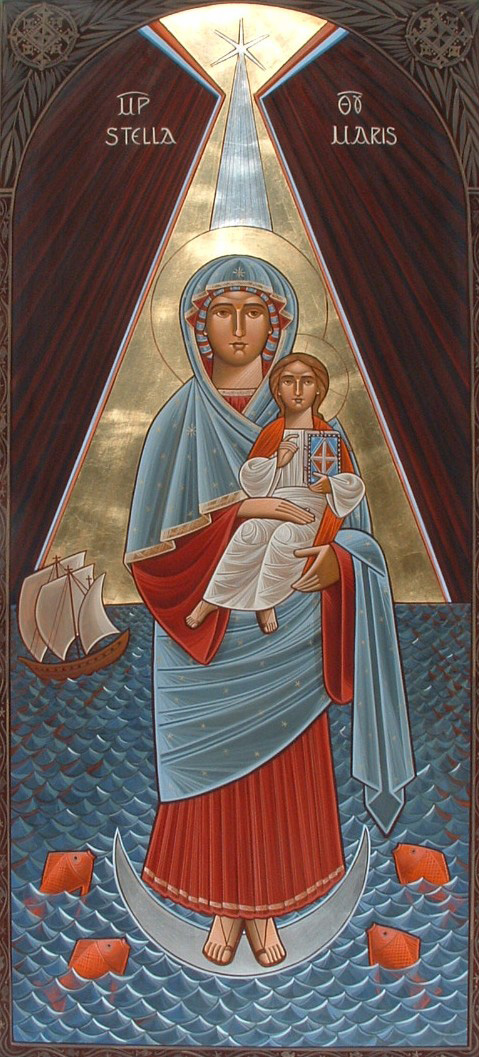
Our Lady of the Sea

Our Lady of the Sea is an ancient title for the Virgin Mary, mother of Jesus Christ. The words Star of the Sea are a translation of the Latin title Stella Maris.
The title Our Lady of the Sea was used to emphasize Mary’s role as a sign of hope and as a guiding star for Christians, especially gentiles, whom the Old Testament Israelites metaphorically referred to as the sea, meaning anyone beyond the “coasts”, or, that is to say, sociopolitical, and religious (Mosaic law), borders of Israelite territory. Under this title, the Virgin Mary is believed to intercede as a guide and protector of those who travel or seek their livelihoods on the sea.
This aspect of the Virgin has led to Our Lady of the Sea, being named as patroness of the Catholic missions to seafarers, the Apostleship of the Sea, and to many coastal churches being named Stella Maris or Mary, Star of the Sea. This devotion towards Our Lady of the Sea with this ancient title is popular throughout the Catholic world.
Stella Maris “sea-star” is a name of α Ursae Minoris or Polaris, the “guiding star” (also “lodestar”, “ship star”, “steering star”, etc.) because it has been used for celestial navigation at sea since antiquity. The name is applied to the Virgin Mary in Saint Jerome‘s Latin translation of the Onomasticon by Eusebius of Caesarea,
Paschasius Radbertus in the ninth century wrote of Our Lady of the Sea as a guide to be followed on the way to Christ “lest we capsize amid the storm-tossed waves of the sea.” At this time too the plainsong hymn “Ave Maris Stella” (“Hail, Star of the Sea”), became increasingly popular.
In the twelfth century, Saint Bernard of Clairvaux wrote: “If the winds of temptation arise;If you are driven upon the rocks of tribulation look to the star, call on Mary; If you are tossed upon the waves of pride, of ambition, of envy, of rivalry, look to the star, call on Mary. Should anger, or avarice, or fleshly desire violently assail the frail vessel of your soul, look at the star, call upon Mary.”[4]Pope Pius XII in his encyclical, Doctor Mellifluus, also quoted Bernard of Clairvaux in saying; Mary … is interpreted to mean ‘Star of the Sea.’ This admirably befits the Virgin Mother.. (for) as the ray does not diminish the brightness of the star, so neither did the Child born of her tarnish the beauty of Mary’s virginity. The idea of Mary as a guiding star for seafarers has led to devotion to Our Lady of the Sea in many Catholic coastal and fishing communities. Numerous churches, schools and colleges are dedicated to Stella Maris, Our Lady Star of the Sea, or Mary, Star of the Sea.Stella Maris Monastery, the foundation house of the Carmelite order was established on Mount Carmel, Israel, in the early thirteenth century. The abbey was destroyed several times, but a refounded Stella Maris monastery is still considered the headquarters of the order. Devotions to this title of Mary are found in the popular Catholic Hymn, Hail Queen of Heaven, the Ocean Star and the ancient prayer Ave Maris Stella. The Apostleship of the Sea has for many years now, been commemorating the Feast of Stella Maris, Our Lady of the Sea with Mass each year on the 25 September. It is a day to pray for all seafarers and give thanks for their contribution to global trade. Masses in 2015 will be held in Glasgow, 10th September, Portsmouth on 23rd September, Southwark, London on 24th September, Aberdeen on 1st October and Plymouth on 8th October. In his 2014 homily at a Mass in St George’s Cathedral, Southwark, London, Apostleship of the Sea’s Bishop Promoter Bishop Tom Burns SM said, “God speaks to seafarers through Mary, Star of the Sea, and through those in the Apostleship of the Sea who act in the name of Mary”.